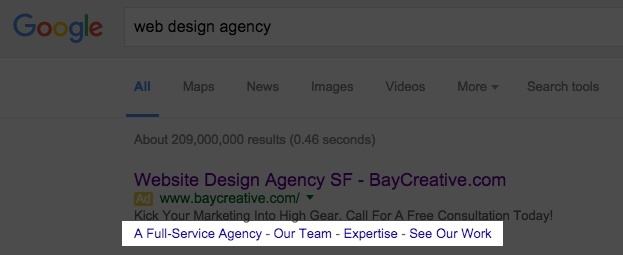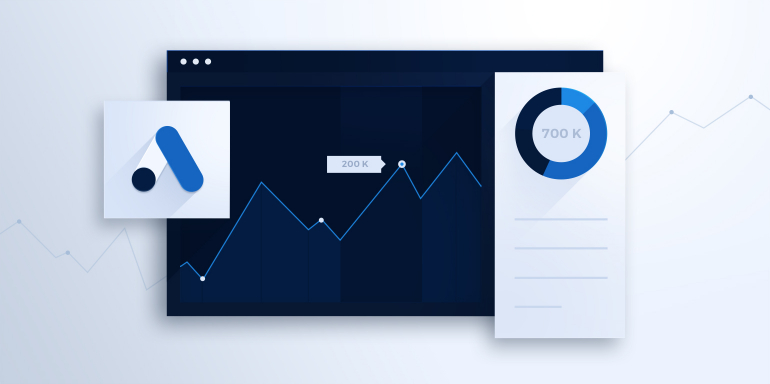Just like building a perfectly optimized post-click landing page, there is a science to creating high-converting, low cost-per-click, Google Ads campaigns.
It’s important to know some basic best practices so you can start off strong without wasting budget and targeting the right audience.
When you first sign in to your AdWords account, you’re shown the dashboard. The dashboard has eight different tabs spanning the top, a search bar, and a multitude of other options to setup your newly-established campaign.

It can be overwhelming, where do you begin?
A standard AdWords ad consists of four lines:
- Headline
- 2 lines of copy
- URL
With the right approach and targeting from the get-go, your AdWords campaigns can be a real money maker for your business — without breaking your bank.
Start with “Search Network only”
AdWords campaigns offer a variety of campaign types, but most advertisers opt for search network or display network.
Search network is a group of search-related websites where your ads can appear, including Google search sites as well as other sites that partner with Google to show ads (search partners).
Then, there’s the display network, a collection of websites, including Google websites like Gmail, Google Finance, YouTube, and Blogger (mobile sites and apps included).
Of the two, the display network has a wider reach and gets you more impressions, but generally lower click-through rates and clicks — even if you target websites where you want your ads shown.
For example, let’s say you’re a check guarantee provider and your target audience is automotive dealers (because they accept a lot of checks for down payments). You could target the “autos” sub-section of Forbes Business, for these types of readers. If you do, you may get a lot of impressions because it’s a highly viewed web page, but the click-through-rate (CTR) will likely be very low and probably won’t get you many post-click landing page conversions from it.
In the end, it may all just depend on your business type, advertising goal, and where your audience lives online. A general good starting point is to stick with Search Network Only.
When creating a new campaign, click on the “Settings” tab and the red “Campaign” button:

So if you’re just starting out, don’t over complicate it — keep it simple. Start with search only, especially if you’re limited by budget and testing out the AdWords platform. Once you see how your ads are performing, you can expand to the display network later to increase exposure.
Bid on relevant keywords
Seems like a no-brainer, right?
If keywords are the foundation for AdWords campaigns, bidding on the most appropriate keywords should go without saying.
Sometimes, though, it’s just not that simple.
Selecting keywords to advertise (and avoid advertising) can be what makes or breaks your AdWords’ ROI. For example, let’s say you’re an advertising agency that offers pay-per-click account management for clients. You probably wouldn’t want to bid on keywords related to website development.
It’s highly suggested you take advantage of AdWords’ Keyword Planner to find related terms. In fact, you’d be better off bidding on some of these phrases, based on average monthly searches:

Also, keep in mind, people browse the Internet using natural language — how they talk.
- “What is the definition of …”
- “Cheap plane tickets”
- “Best email marketing software”
This brings us to keyword matching options. These are the plus signs, quotations, and brackets advertisers can use on keywords (withing AdWords only) to target audiences better:

Then, there’s negative keyword lists (the minus sign). Negative keywords are words and phrases you’ve chosen to block your ads from showing because you don’t want to be charged if people click. It’s also one of the biggest ways to save money in your AdWords campaigns. Negative keyword lists can be set at the campaign level or the ad group level. Whichever you choose, continue to add more search phrases and refine your campaign accordingly.
Schedule your ads
Similar to bidding on relevant keywords, it’s best practice to only run your ads when it’s most beneficial to you. For example, if your business only operates during standard hours (8am – 5pm), you may not want to be running ads at midnight.
To set up the days and times you want your campaign to run, choose “Search Network Only” and then “All Features.” Once your campaign has been created, you can manually set your campaign schedule however you see fit by clicking “Settings” tab and then “Ad Schedule:”

AdWords extensions
Extensions make your ad bigger, give you more lines to work with, draw more attention, and allow you to highlight more features and benefits.
Google only displays a maximum of 10 ads per page. Depending on your industry and the related keyword search phrases, earning one of those coveted spots can be incredibly competitive.
Being ranked on page one (and high up on page one) makes all the difference when it comes to the likelihood people searching click on your ad. This is where AdWords extensions can help you stand out and climb the rankings. In fact, AdWords may “penalize” you (so to speak) if you don’t include extensions in your ad. This is because they want people to have the most enjoyable browsing experience possible — and including a variety of extensions helps in that regard. To setup extensions, go here.
Let’s say I was searching for a web design agency. The top ad uses Sitelink extensions, highlighted here:

Each extension directs the user to a different page on their website. Leading people to the homepage or any web page is not a best practice for PPC and conversion optimization (they should be going to a dedicated post-click landing page). However, the extensions make the ad bigger and help it rank number one.
One extension it is lacking is a call extension, especially because their ad copy says “call for a free consultation:”

If Bay Creative were to add a call extension, users would see Bay Creative’s phone number appear on desktop, and a phone icon would appear if the user was searching on mobile (click-to-call).
Of course, not all extensions apply to all businesses. Case in point, a coffee shop or florist. These business types could add a location extension. On the flip side, a SaaS startup would most likely not find a location extension valuable to its business.
Choose your extensions wisely and start getting noticed more often.
Summing Up
Google AdWords is one of the best methods to generate post-click landing page traffic and convert prospects into leads, and nurture them to a sale. Setting up a new campaign can seem tedious and overwhelming, but once you have the basics down, it’s not that bad.
Once your campaigns have been active and generating data, analyze what keywords have been producing for you, what time of day should they run, what extensions are providing value, and more.
Remember, Google Ads campaigns are only a small part of the conversion equation. Creating an optimized post-click landing page is a crucial piece as well. Build a professional post-click landing page today and watch your Google Ads spend generate high quality leads!
